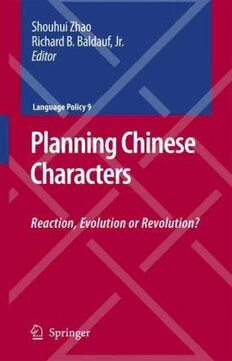
Planning Chinese Characters: Reaction, Evolution or Revolution? (Language Policy) PDF
435 Pages·2007·5.791 MB·
Most books are stored in the elastic cloud where traffic is expensive. For this reason, we have a limit on daily download.
Preview Planning Chinese Characters: Reaction, Evolution or Revolution? (Language Policy)
Description:
The People’s Republic of China (PRC) is a growing, developing, dynamic society that is moving to take its place as a major world power. Having the world’s largest population, it is estimated that sometime in the next 10 years, China’s economy will become the world’s largest. This development has led a number of language experts to predict that as this power and influence grows, so too will the spread of the Chinese language, with some suggesting that it will surpass English as the world’s most common lingua franca. However, for the Chinese language to grow in power and influence, a number of hurdles must be overcome, in particular the challenges of technology. The barriers to growth and spread of the Chinese language are very different for spoken and written Chinese, and this monograph focuses on the written variety. It traces the language policy and planning related developments for Chinese characters, with particular emphasis on post-1950 period in the People’s Republic of China (PRC) and the more recent challenges that technology, and particularly the World Wide Web, have posed for the language. While Chinese language policy and planning developments can generally be characterized as evolutionary, currently there are forces, both reactionary, i.e. elements of traditional language and cultural purism, and revolutionary, i.e. ‘alphabetic’ or radical simplification schemes, at work in the PRC. The volume examines this linguistic, cultural, political, economic debate, the outcome of which could determine whether Chinese reaches its international language potential, and explores some possible language policy and planning directions for the future. Given the importance of China and potential of the Chinese language, understanding of these issues is critical for not only our understanding of China, but also for second language policy as it relates to Chinese around the world.
See more
The list of books you might like
Most books are stored in the elastic cloud where traffic is expensive. For this reason, we have a limit on daily download.
